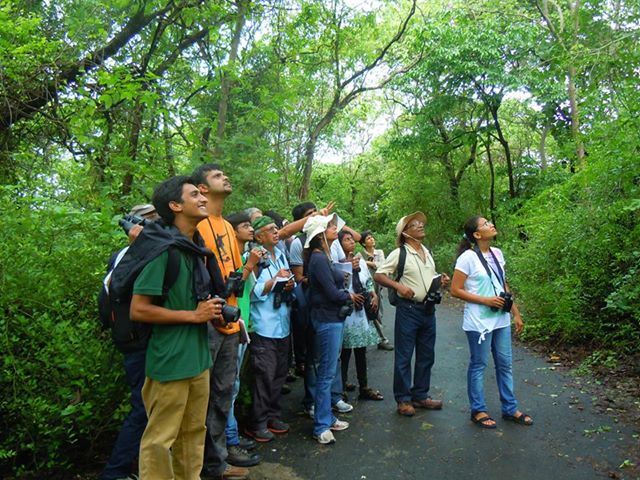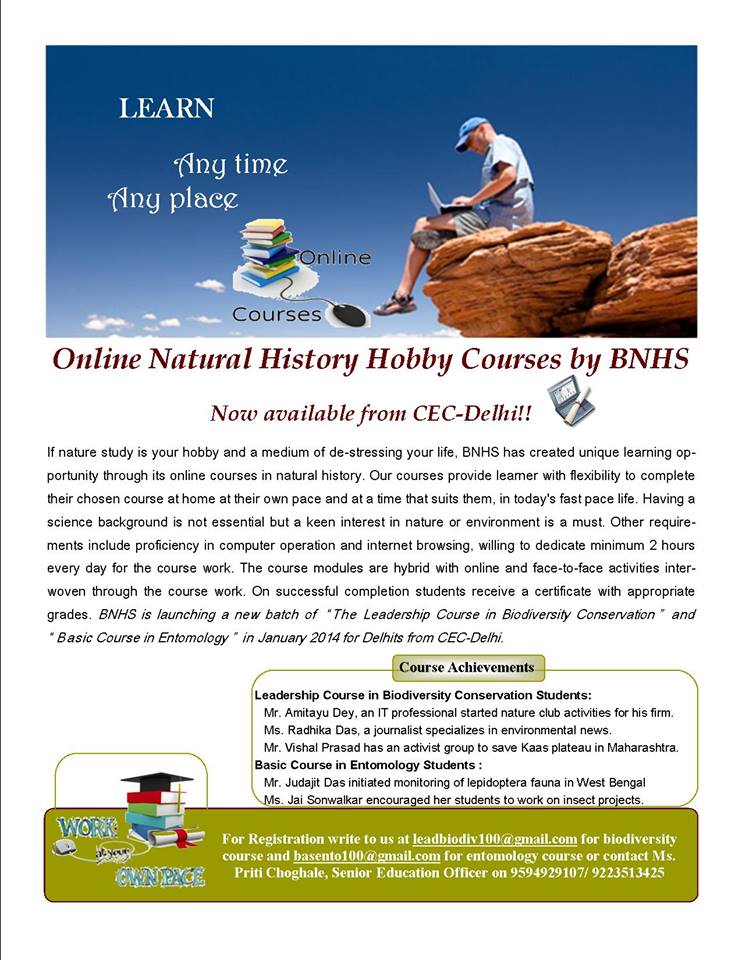Online Environmental Courses
Our Club is proud that 24 of our members are enrolled in the one year certificate programs offered by BNHS.
All twenty four of them, leaders in their own right, are now poised to take on larger roles to protect the environment around them. Team IWC and the Community of 6300+ members wish them the very best for the future. Team
IWC request you to
feel free to share your unique experiences in learning at the premier Natural History Organization in the country(BNHS) with IWC members. You can do this effortlessly by using our member upload features.

Participants of Ornithology appreciating Birds during a Nature Trail
Here are brief details about the participants.
Program BCO
Chetan Ramamrthy (chetan.ramamurthy@outloook.com)
Chetan is a software developer and enjoys field bird watching and photography.
He wants a more formal and scientific understanding of birds and its habitats so that he can contribute to its conservation and also improve his photography. He would like to introduce more youngsters into ornithology and
guide them towards conservation of the wildlife.
Dr.T.S Rawal (tsrawal@gmail.com)
A chartered accountant by profession, Dr. Rawal is a birder and bird photographer for long. To his credit are some of the rarest sightings, such as Red Phalarope, and Caspian Plover. He also has to his credit sightings of
birds in Nagpur which were never recorded in Nagpur before ( such as Eurasian Hobby, Blue throated Blue Flycatcher, Rubythroat ) His bird pics have been published in many publications- More than 300 images in Oriental Bird Images database.
He expects the course to provide him the theoretical foundation which will help him do better in the field work that he is already doing. He has trained Forest officers and guides in identifying birds, has held courses
on birding for students, and has been helping people know birds.
Deepak Rajanna (deepakar@gmail.com)
A software professional, Deepak has been a keen bird watcher from his childhood days but never got a chance to formally earn ornithology. Even with his limited knowledge he has converted many of his friends and relatives into
birdwatchers. With the knowledge he gains from the course he intends to convert many more people.
Naveen Shanmugaraj (airfoil@gmail.com)
Naveen is a businessman and has been a past member of the Birdwatchers Society of Andhra Pradesh, between 1990-93. He hopes to gain a better understanding of the avian fauna through the course. He also plans to contribute
to BNHS with survey/photographs and participate in BNHS programmes.
Ajay Jaisinghani (ajayjaisin@gmail.com)
Ajay is an entrepreneur who wishes to learn about birds and identify birds in the neighbourhood. He wishes to be part of the birding community and educate others about birds and ornithology.
Pallavi Kaiwar (kaiwar.pallavi@gmail.com)
Pallavi is Director, Engineering and looks forward to gain basic understanding of birding. She would like to support scientific research and society education.
Jaishankar V (jaishankar@vanamitra.org)
Jaishankar is the trustee of a wildlife conservation NGO. He wants to learn more about birds, especially their migratory patterns and the season, Food habits, Breeding etc. He plans involving more people in to ornithology
by creating awareness and also protection of habitat by involving Common people.
Nakul Gupta (nakul.gupta@ge.com)
Nakul is a Sales Director. He has been an amateur ornithologist since age 13. He is a member of the Delhi Bird Club and
participates in birding trips on weekends. He also maintains an album of his bird photographs and regularly visits national parks and the Himalayas for birding. He wants to gain a formal theory cum practical foundation to ornithology
which would help hone his knowledge in this domain. He is very keen to contribute to the body of scientific research in the field of ornithology by writing research based papers. He would also like to apply the learnings from this course in promoting awareness
about birds and would like to contribute actively towards preservation of bird habitats and wildlife conservation.
Vikram Batra (vikrambatrairs@gmail.com)
Vikram is a senior Government servant. he has been bird watching for a few years but it has been in fits and starts. he was
a regular at the Ohkla Bird Sanctuary in Noida(UP) and has visited Keoladeo Ghana at Bharatpur also a couple of times. He would like to get more involved with the process of bird watching and learn more about bird species in terms of the role of
birds in the eco system, their different characteristics. Birds are a good indicators of the changes taking place in the environment, globally. He hopes to be involved in conservation efforts and doing his bit to spread the message about the importance of
birds.
Santosh B.S (santosh.badri@gmail.com)
Santosh is an IT-Business analyst. and considers himself a novice bird watcher who often is found in the field.
He hopes to learn in detail the behaviors and other secrets of the avian world. He plans to "Share / Educate / Empower".
Sasidhar Akkiraju (sakkiraju@gmail.com)
Sasidhar is a product mananger in IT. He wants to get a good grasp of the right methods for learning more about birds.
He intends to spend considerable amount of time and effort studying bird behavior.
Shobita Asthana (shobita.asthana@gmail.com)
Shobita is a teacher who wants to earn about Birds besides environment. She plans to sensitise people and children in particular about the environment.

Mr. Kaustubh Bhagat Interacting with Participants of Herpetology Course.
Program BCH
Amatya Sharma (conservewithme@gmail.com)
Still a student, he has already attended workshops with TGMP (The Gerry Martin Project)at ARRS (Agumbe), Hunsur, MCBT (Madras Crocodile Bank Trust);Venom extraction projects with Romulus Whitaker at Leporiang, Arunachal Pradesh and
Wayanad,Kerala. Workshops with Herpactive, in Goa and Karnataka. He hopes to equip himself with the required skills and knowledge which are essential for a Herpitologist. He wishes to spread awareness among the common man with regards to the importance
of herps in our ecosystem. Reduction of Man-Herp conflict is another of his aims. In future he would like to conduct some research on reptiles and amphibians.
Girish K (girish.cfc@gmail.com)
Girish is a Senior Control Engineer. He has volunteered in rescuing snakes and releasing them in wild with People for Animals Organization at Bangalore. Their task was to rescue snakes(russell viper, spectacled cobra, rat
snake, etc) from human habitat and release them in a protected Sanctuary. He is expecting to learn various behaviors of the amphibians and reptiles. How to carefully handle them. He would like to educate people(living in urban and rural area) regarding the
wonderful world of amphibians and reptiles. Solve human - herp conflict. Rescue snakes and release them in protected area.
Avinash Vora (avora1386@gmail.com)
An executive trainee, Avinash is interested in learning herpetology.
Shweta Dhiman (dhiman.shweta@gmail.com)
Shweta is an iT co-ordinator who wants to learn the basics of herpetology and to be able to apply them in the welfare and conservation of herps. She would apply her knowledge in conservation of the herps and reptiles in
what ever way she can.
Also she would be able to educate people about the existence and importance of these animals around us.
Shaunak B.Modi (shaunak@projectbiwan.com)
Shaunak is a partner in a clothing firm and though Ihe has a keen interest in wildlife, most of his knowledge is about the big cats. He expects to change that by taking this course. From this course he expects most to learn
about crocodiles, turtles and snakes, which are some of his favourite herpeto-fauna. Human-Wildlife conflict is one of the most serious issues affecting all wildlife populations in India. Though Man-Leopard/Tiger conflict gets attention in the news media,
he has not noticed the same about herpeto-fauna.He would like to understand this issue better and help in creating awareness and also help in any way he can, people who are working in field for it.
Aneesha Kumar(aneeshak@gmail.com)
Aneesha is a research analyst. Acquiring knowledge through research and field experience in the basics of herpetology is the purpose for joining the course, besides opportunity to explore diverse habitats for learning and
photography. She plans to volunteer at organizations involved with nature and habitat conservation.

Ms. Priti Choghale, Interacting with the LCBC participants on the Nature Trail
Program LCBC
Sophia Kurien (sophiakp@yahoo.com)
Sophia is a Denist Professor, who has volunteered with centre for wildlife studies for counting prey species in Nagerhole, Bangalore, tree planting and organising conservation related seminars in schools for children with wild
forever foundation. She hopes to better understand wildlife and how to contribute to conservation by doing the course. She plans organising educational workshops in India and Austria for wildlife conservation.
A.Srinivas Ravi Kumar (ravikumar707@yahoo.com)
A Sales Manager, Srinivas wishes to have an understanding on the conservation of bio diversity and contribute to it.
Bhagyashri More (bhagyashrimore029@gmail.com)
Bhagyashri is a biotechnologist who wishes to have field experience in wildlife science. She would love to work with NGOs and take up nature conservation projects.
.Manasi Sapre (saprem.ms@gmail.com)
Manasi is in the media industry and would like to learn the basic tools of nature conservation. She would like to contribute to natural conservation full time eventually.
Program BCE.
Anoop (pranksta7@gmail.com)
Anoop is an associate HR. He wants to learn more about nature, and help them not to be a memory. After the course he would have a different persepctive, he would love to research on insects and their whereabouts. Insects
fascinate him.